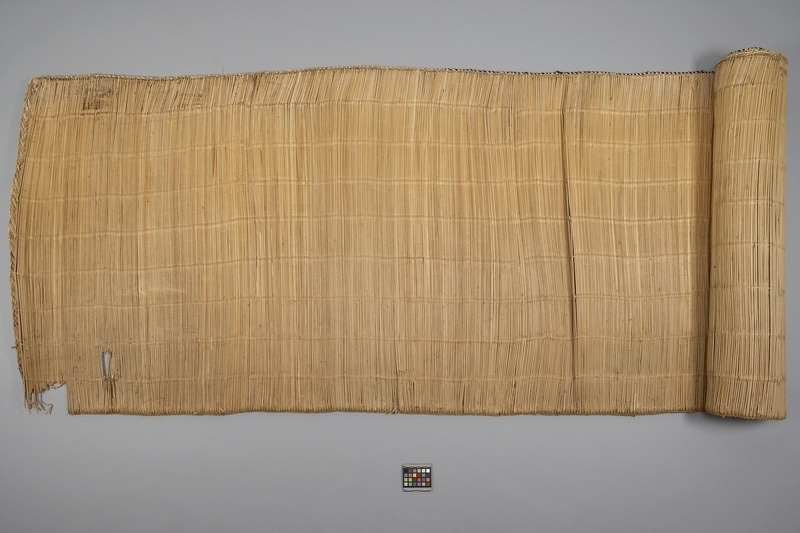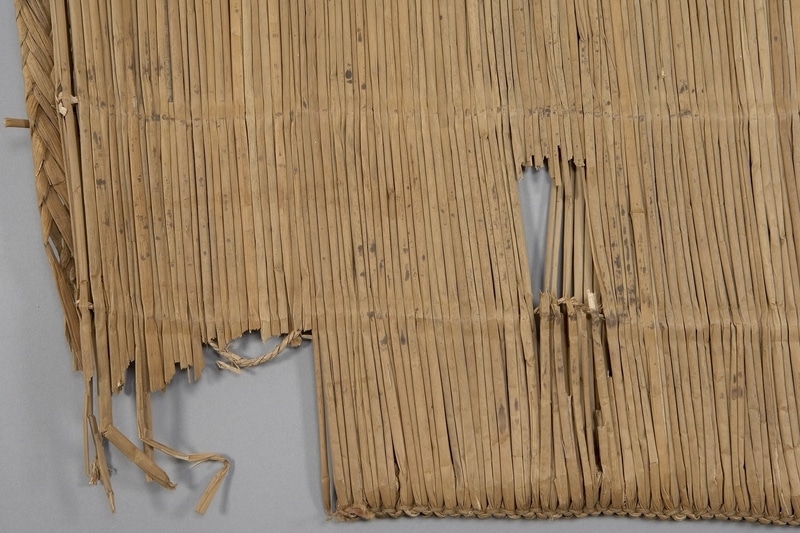Mat Item Number: 1096/2 from the MOA: University of British Columbia



Description
Plain mat of parallel light brown tule reeds. Black wool and red twine woven into side bindings. Double layer of weaving. Woven strips attached to both ends with braided trim.
History Of Use
Mats of cattails or tule reed stems were produced by Salish groups. Homer Barnett notes that cat-tail was "an all-purpose fabric and turned the rain very well. In summer, long mats covered the framework of temporary dwellings. In winter, they padded the walls of the plank houses. At all times they were used to sit, to eat, and to sleep on, and as coverings and paddings of various kinds (1955:122)." Sizes varied depending on the purpose, and most families would possess a range of sizes.
Cultural Context
shelter; transportation; domestic
Specific Techniques
The leaves used for making cat-tail mats are gathered in the summer, cut to even lengths, dried in the sun on the beach, and then stored until needed. The leaves were layed out side by side, alternating the tops and bottoms, and threaded at 10 cm intervals (SeeTurner, 1979, p150). The cat-tail mats were then sewn together by passing a long hardwood needle through a series of stems, then crimping the stems over the needle with a coarse wooden creaser to prevent splitting, before drawing the thread through. (By contrast, tule mats are twined together with cordage).
Item History
- Made in British Columbia, Canada
- Collected in Cowichan Bay, British Columbia, Canada
- Owned by Northwest Trader before December 16, 1985
- Received from Northwest Trader (Seller) and Museum of Anthropology Shop Volunteers (Funding source) on December 16, 1985
What
- Name
- Mat
- Identification Number
- 1096/2
- Type of Item
- mat
- Material
- tule grass, wool fibre and plant fibre
- Manufacturing Technique
- braided, twined, creased and sewn
- Overall
- height 440.0 cm, width 105.0 cm
Who
- Culture
- Coast Salish: Quwutsun'
- Previous Owner
- Northwest Trader
- Received from
- Northwest Trader (Seller) and Museum of Anthropology Shop Volunteers (Funding source)
Where
- Holding Institution
- MOA: University of British Columbia
- Made in
- British Columbia, Canada
- Collected in
- Cowichan Bay, British Columbia, Canada
When
- Ownership Date
- before December 16, 1985
- Acquisition Date
- on December 16, 1985
Other
- Condition
- poor
- Accession Number
- 1096/0002